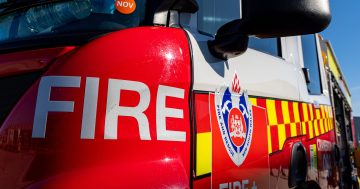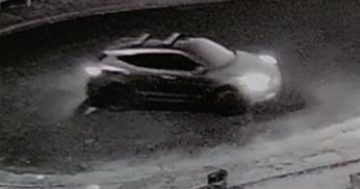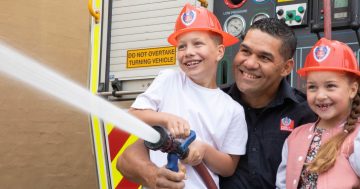
NSW Police are investigating the cause of a house fire in the town of Young on Monday, 7 June. Photo: NSW Police.
Forensic police are examining the scene of a fire which left a house in Young extensively damaged on the night of Monday, 7 June, as fire authorities warn residents to take extra care as temperatures plummet this week.
Emergency services were called to the house in Wombat Street around 6:00 pm on Monday after a neighbour reported seeing smoke emanating from the building.
Young Police Inspector Jacob Reeves said that on arrival at the property, Fire and Rescue NSW officers found the house well alight. They entered the building and extinguished the flames.
The occupants were not home at the time of the fire and nobody was injured as a result of it, nor were any adjoining building affected.
Inspector Reeves said at this stage there are no suspicious circumstances surrounding the incident, but NSW Police have established a crime scene to allow for a full investigation.

This house in Young was extensively damaged by fire on Monday, 7 June, while its inhabitants weren’t home. Photo: NSW Police.
The incident follows another house fire near Yass on Sunday, 6 June, which left one man seriously injured.
At about 1:00 am on Sunday, emergency services crews from both NSW and ACT responded to reports of a house fire in Gooromon Ponds Road, Wallaroo, approximately 40km south of Yass.
Eight occupants were able to escape the home when fire broke out, however an 83-year-old man suffered smoke inhalation and burns.
He was treated at the scene by ACT Ambulance officers before being taken to Canberra Hospital.
Fire and Rescue NSW, ACT Fire and Rescue, and Wallaroo Rural Fire Service worked to control the blaze but the home was destroyed.
Officers from Hume Police District attended, established a crime scene and commenced an investigation.
The fire is not being treated as suspicious.
Fire and Rescue NSW Commissioner Paul Baxter said the best way to stay out of harm this winter is to “take measures to prevent a fire from occurring in the first instance”.
Last week, Fire and Rescue NSW launched its winter fire safety campaign where firefighters demonstrated how quickly a bedroom fire can take hold. In just a few minutes, bed sheets caught alight from a heater and the room was destroyed.
Commissioner Baxter said Fire and Rescue NSW typically sees a 10 per cent increase in the number of residential fires during the cooler months of the year due to heaters, electric blankets and overloaded powerboards.
In the winter of 2020, firefighters attended more than 1000 house fires across NSW. Every year, approximately 20 people die across the state from fires that could have been prevented.

Overloaded powerboards are a common source of residential fires in winter. Photo: Fire and Rescue NSW.
Commissioner Baxter urged residents to have a working smoke alarm in their home and to test it regularly.
ACT Minister for Police and Emergency Services Mick Gentleman said now is the time for residents to think about the fire risks within their home and ensure they know what to do if a fire starts.
“Fire caused by heaters and dryers increased in the ACT in 2020, and kitchen fires continue to be the leading cause of home fires every winter,” he said.
“ACT Fire and Rescue is working with the Canberra community to reduce the risk of heater, dryer and kitchen fires in the home, and educating people on how to safely respond if threatened by a fire.
“Most of these fires are preventable. We are reminding the Canberra community to keep flammable materials at least one metre from a heater, to regularly clean the lint filter in your dryer, and not to leave cooking unattended.”
ACT Fire and Rescue Acting Chief Officer Matthew Mavity said with residential fire spread rates increasing due to open-plan living, its important residents understand how to safely extinguish a small fire.
“Understanding what actions to take if a fire was to start in your home – such as using a fire blanket or extinguisher – can reduce the amount of damage sustained,” he said.
“This winter, we will be educating the Canberra community on the simple actions they can take to ensure the safety of themselves, loved ones and their property.
“Of course, if a fire does take hold in your home, the safest thing to do is to get out and call triple zero (000).”
For more information on preparing for winter, including checklists and fire safety tips, visit NSW Fire and Rescue’s Winter Safety Campaign and the ACT Emergency Services Agency.











